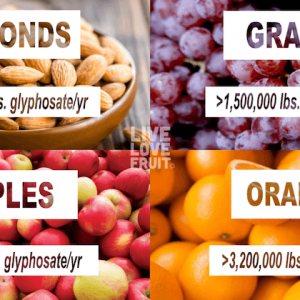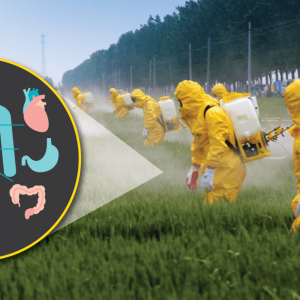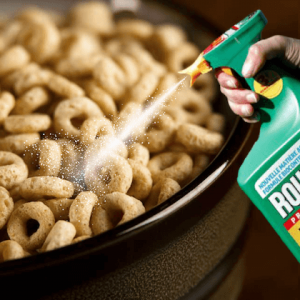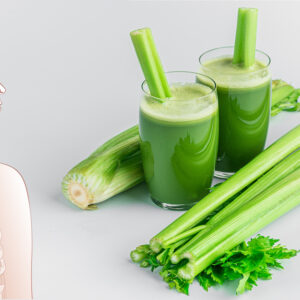
It seems Monsanto’s toxic chemical glyphosate has now found its way into wine. It isn’t surprising, however, seeing as how grapes are pesticide and herbicide-laden.
Glyphosate has been showing up in foods both directly sprayed, and even foods that haven’t been sprayed, such as organic produce. It is the active ingredient in Monsanto’s Roundup herbicide, and has been used since 1974.
Recent research has suggested that glyphosate will “likely remain the most widely applied [herbicide] worldwide for years to come, and interest will grow in quantifying ecological and human health impacts.” The study showed that in 2014, farmers sprayed enough glyphosate to apply 0.8 pounds of the chemical to every acre of cultivated cropland in the U.S.
100 Percent of Wine Tested Contained Glyphosate
A supporter of Moms Across America went ahead and sent 10 different wine samples, from large and small vineyards, to Microbe Infotech Lab of St. Louis. What they found was shocking. The active ingredient in Monsanto’s Roundup weedkiller, glyphosate, tested positive in both conventional, and organic wines (although organic wines had significantly lower levels).
The test results showed that all 10 samples tested positive for glyphosate. The highest level detected was 18.74 parts per billion (ppb), which was found in a 2013 Cabernet Sauvignon from a conventional vineyard. This is 28 times higher than all other samples tested.
The lowest level detected was 0.659 ppb, which was found in a 2013 Syrah, a biodynamic organic vineyard, which, according to the owner, has never been sprayed.
All wines were from the North Coast region of California, the premium wine growing region of California and includes wines from Napa, Sonoma and Mendocino counties. The wines were sent in Sept of 2015 and February of 2016 in two separate groups.
The wine brands tested included:
– Gallo
– Beringer
– Mondavi
– Barefoot
– Sutter Home
So essentially, stay away from all wines made from California vineyards if not organic.
New Study Reveals Similar Results
This isn’t the only study that has revealed toxic weedkiller in alcoholic beverages. A new study released in March of 2019 confirmed that beer and wine are not safe from the cancer-causing weedkiller.
To explore how much Roundup the average person drinks, the U.S. PIRG tested 15 beers and 5 wines for glyphosate, the weedkiller’s active ingredient. Of the 20 samples tested, all but ONE contained glyphosate, and 3 out of 4 organic beers and wines contained glyphosate.
Brands with the highest concentration of glyphosate were as follows:
Wine
1. Sutter Home Merlot: 51.4 ppb
2. Beringer Founders Estates Moscato: 42.6 ppb
3. Barefoot Cabernet Sauvignon: 36.3 ppb
Beer
1. Tsingtao Beer: 49.7 ppb
2. Coors Light: 31.1 ppb
3. Miller Lite: 29.8 ppb
4. Budweiser: 27 ppb
5. Corona Extra: 25.1 ppb
6. Heineken: 20.9 ppb
7. Guinness Draught: 20.3 ppb
Other brands also came up positive for glyphosate, but at lower levels.
Health Concerns Over Glyphosate
Exposure to glyphosate at doses nearing the 0.100 ppb mark completely destroy beneficial gut bacteria, and exposures higher than that can cause breast cancer, destroy nerve cells, and damage the kidneys and liver. It can also cause miscarriages, as it destroys the placenta in pregnant and fertile women.
Since 1974, America has used over 1.8 million tons of glyphosate, with over 9.4 million tons having been sprayed on crops worldwide.
The World Health Organization finally declared that glyphosate is “probably carcinogenic to humans” in their International Agency for Research on Cancer in March 2015. That isn’t to say that Monsanto necessarily agrees, however, as they have been actively trying to fight this claim since then.
A simple Google Scholar search on glyphosate reveals its effects on health:
– stimulates the growth of human breast cancer cells
– chronic inflammation
– leaky gut
– endocrine-disrupting effects
– cell death
– neurotoxic to brain cells
– reproductive problems
– oxidative damage
– modifies sex hormone balance
– birth defects
– wipes out beneficial gut bacteria
How Does Glyphosate End Up In Wine?
As we all know, wine is made from grapes, and these grape plants are sprayed by Roundup. Roundup is used on every crop grown conventionally around the world. Contaminated soil can also retain these chemicals for over 20 years thereafter.
Back to the grape plants. Glyphosate (the active ingredient in Roundup) enters the plant through its roots. It is then taken up into the plant and quite literally embedded in the DNA and cell-fluid of the grape. Sounds tasty, right?
Vineyards aren’t the only crop susceptible to Roundup spray.
An EPA memo from October 2015 revealed a variety of popular food crops sprayed with Roundup. Even more shocking, is that when you compare this list, to the previous data from 2011, it shows that glyphosate use for popular food crops has continued to grow at an alarming rate.
Things like almonds, corn, grapes, oranges, sorghum, soy, sugar beets, sunflowers and wheat recieve well over one million pounds of glyphosate annually.
Cotton, another highly-sprayed crop, also receives around 18,400,000 pounds of glyphosate annually. So it’s not just in the foods or drinks you consume, but also on the clothes you wear.
Not Just Glyphosate?
Glyphosate is dangerous, but it is also important to be aware of other co-formulants present in glyphosate-based herbicides, which have been shown to be hormones disruptors and are 1000x more toxic than glyphosate alone.
According to a study by the International Journal of Environmental Research and Public Health:
Up to now, the endocrine-disrupting effects of pesticides have been studied mostly based on tests on their declared active ingredient. Here we report for the first time that, below their toxicity thresholds, the co-formulants, generally classified as inerts and kept confidential, act as endocrine-disrupting chemicals at levels up to several hundred times below the level at which the declared active ingredient demonstrates the same activity. Glyphosate is never used alone, but always with its co-formulants. Thus the physiological effects of co-formulants should be more thoroughly tested and declared. We also recommend that the calculation of the ADI for pesticides should be based on toxicity tests of the commercial formulations rather than solely the declared active ingredient.”
It is important to understand that glyphosate is toxic, no matter what the companies (who directly support or work for Monsanto) have to say. It kills the crops it’s sprayed on, and so crops are genetically engineered to be able to survive exposure to the chemical. We should NOT be eating these crops!
Not Just Wine!
Other alcoholic drinks, like beer, have also been found to contain the nasty chemical glyphosate. A report from Germany showed that 14 beers tested positive for glyphosate.
Glyphosate is also found in pretty much all conventional foods grown worldwide, so if you’re not too keen on drinking conventional wine or beer, you might also consider switching eating habits from conventionally grown food items to organic, local or home-grown.








I am shocked but not surprised. Great has no limits and has no concern for the future of our globe.
Okay, so I’ve worked for both Mondavi and Beringer and here are my thoughts. This article is not factually accurate. They only tested 10 wines, which is not scientifically significant to make such a scary claim. Further, they say there were Organic and Bio Dynamic wines tested, but none of the six brands listed sell such a wine (so where was that data acquired)? And finally, they say the wines all came from the Northern California appelations, but all six of these wines are “California” or “USA” Appelated and are all sourced from the Central Valley (Lodi or Modesto Counties). So what’s the truth here? I can tell you this – the article is leaving out or making up much of their reporting…
Hey Seth – I am a very busy person, and when there are over 400 comments to respond to, it takes me awhile to get to ones like yours. This is not the only study done on pesticides in wine/beer. Here is a more recent one (which I reference in this article): https://livelovefruit.com/glyphosate-in-beer-and-wine/
What do you do to avoid as much exposure as possible or to counteract the effects?
Please include a discussion of the components of the hemp plant if you can
I would say consume as much organic foods as you can! While it may still get contaminated via airways and waterways, it will still contain the lowest amounts. Growing your own is also a great alternative.
Roundup goes by another name: MiracleGro. It’s being sold everywhere for home gardeners. Pay attention folks!